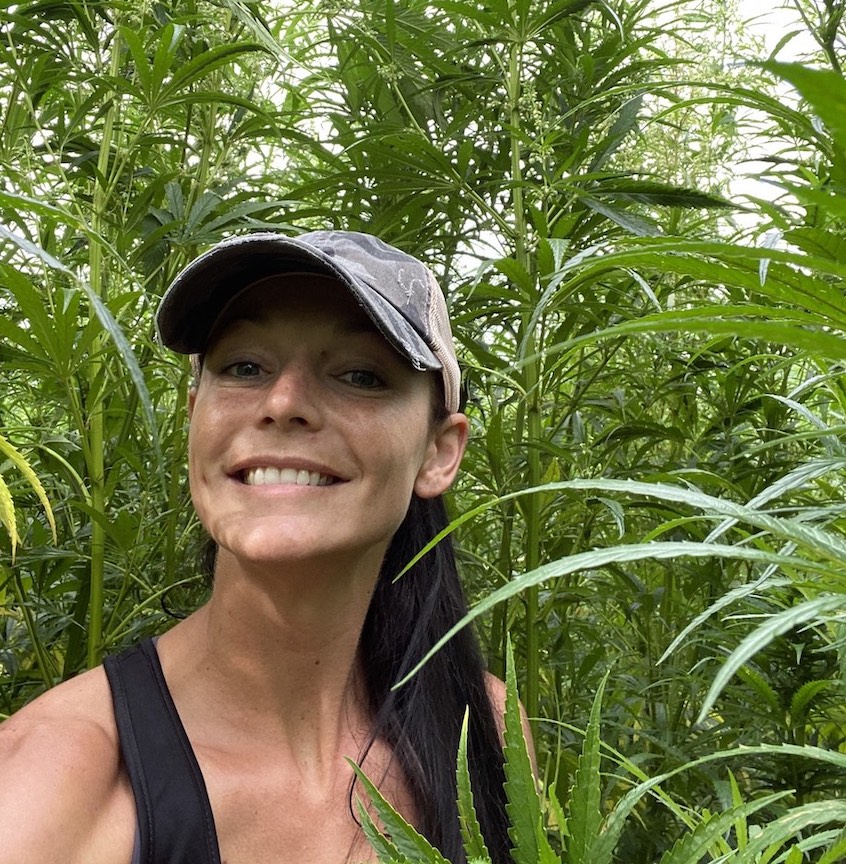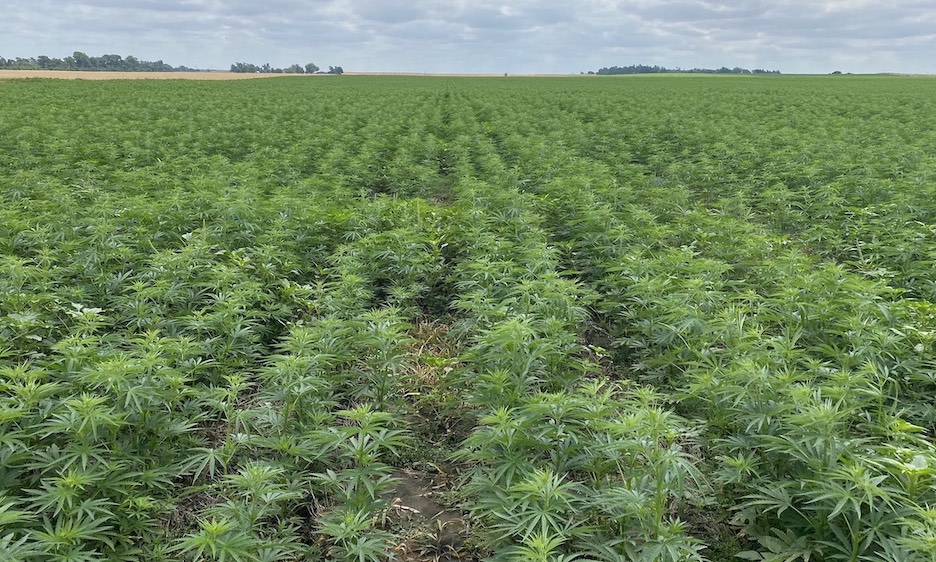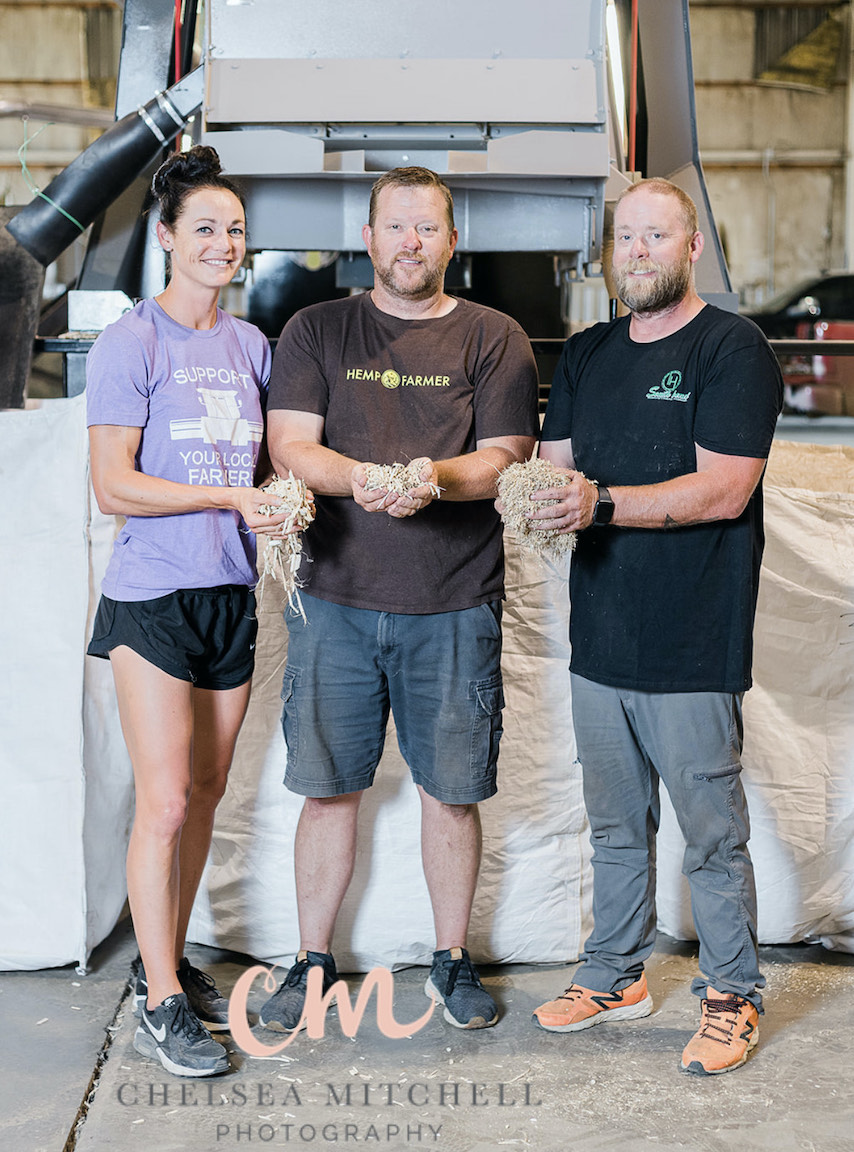Hemp Blueprint Thrives on Midwest Farm

The early, buck-wild days of hemp farming spawned many a gun-shy grower, but Aaron Baldwin found a sweet spot. Avoiding the pitfalls of broken promises and grinning middlemen, Baldwin brought hemp processing home and established a corresponding grower group. “Good times or bad times, any real farmer is always looking for genuine opportunity, and we knew the numbers were right,” he says. “It was time to s*** or get off the pot.”
Welcome to the near bull’s-eye of Kansas and the first industrial hemp fiber processing facility in the Jayhawk state, spurred by the entrepreneurial eye of a farming family with roots in 60 years of corn and soybeans. Is South Bend Industrial Hemp (SBIH)—farmer conceived, sourced, owned, and managed—a close blueprint for the future of American hemp?
The Bottleneck Trap
On the flat, sandy soils south of the Arkansas River in central Kansas’ Barton and Stafford counties, the Circle K Farming Partnership is steered by the trio of Baldwin and his wife, Melissa, and his brother, Richard.
Circle K encompasses 2,500 acres of row crops (3,000 acres total), typically set on an irrigated corn-soybean rotation, with wheat also in the mix, along with grain sorghum depending on the year and circumstance. In addition, the operation includes a feed yard with a 2,000-head capacity, but the livestock ground is leased out. Baldwin, 46, carries a wry sense of humor and a strong dose of self-deprecation, and describes himself as “in no way a full-blooded cattleman.”
The Baldwin brothers took over decision-making on the family farm in 2011, and assumed the official helm in 2018, allowing their mother, Karla Kirkman, to step backward into a landlord role. At roughly the same time in 2018, the hemp train left the federal station as regulations eased and opportunity opened for growers—and grifters. The stampede took CBD prices to dizzying heights, attracting carpetbaggers and con-men to a new crop with no genuine market rules.

While the hemp buzz increased, Baldwin searched for a new player for his crop roster, finding modest success by growing 200 acres of teff for a buyer in Colorado, but the shine of high hemp prices caught his eye, particularly the opportunity to scale.
“Me and Richard started looking to grow hemp for CBD and we had all kind of guys romance us. We were told a $500,000 facility with geothermal heating and all sorts of bells and whistles was the way to go. No way. On this farm, we always start simple. I’ve already got to gamble in farming every damn day, and there was no way we were gonna spend more than necessary.”
“We wanted to bet what we could afford to lose,” Baldwin continues. “It’s what we tell other guys today, ‘Start small.’ There are true horror stories out there of guys investing millions and losing it all.”
The Baldwins built a hoop house (2,000 square feet) for $10,000 and ran in water lines via a drip system. The rationale? If the hoop house didn’t work for CBD, the structure could be turned toward vegetable or specialty crop production. Obtaining clone genetics from Tennessee, they raised 1,500 plants (indoors and outdoors) and had an excellent first-year growing experience through harvest. (The Baldwins also grew 80 acres of fiber, but weren’t satisfied with tonnage production and didn’t harvest the crop due to weed and insect pressure.)
The CBD hemp, however, was a slog: The promised processor dropped the ball. “He was an extractor out of Colorado who was supposed to take all our biomass,” Baldwin explains. “It was all done on a shares deal so we weren’t out cash. But we were at the tail-end of high prices, which had dropped from $4,000-$5,000 per kilo to less than $2,000, and the processor was out. We pulled in the reins and regrouped.”
“Eventually, we found an extractor in Kansas with a strong reputation, the same guy we still use. It’s crucial in hemp to vet and do research about who you’re working with. It’s a small industry and you can learn a lot if you keep asking questions.”
The following year, in 2019, the Baldwin trio added a successful fiber field, growing 4.5 tons per acre on half a pivot. With product (300-plus bales) ready for processing, the Baldwins ran into a déjà vu scenario. Bottom line, the processor jumped ship. “We were supposed to take the bales to a guy in Texas for decortication, and he said he was happy with every shred of fiber we could grow. Suddenly, he was out. No buyer.”

Two steps forward, three steps back. Frustrated, but convinced he was on the right track, Baldwin kept his nerve. “Long story short, I rounded up the troops and told them, ‘If this processing gap between farmers and manufacturers isn’t made right, then we’ve got to quit.’ We were stuck in the bottleneck of the U.S hemp industry that is fed right now by product out of Canada and overseas. These U.S. companies can’t dependably source American-grown hemp, but they want all they can get.”
Rather than throw in the towel, Baldwin solved a monumental processing problem with an on-farm, DIY solution. Welcome to the birth of South Bend Industrial Hemp (SBIH).
Pinky Chop
With Melissa crunching the numbers, the Baldwins weighed the possibility of building an industrial hemp processing facility. Three years after starting down the hemp road, the trio pulled the trigger. “We were diligent on research,” Baldwin emphasizes. “We knew it would work and we were being conservative.”
Baldwin looked at decortication machines and spoke with contacts in the processing industry, but initially found extremely limited options for American-made equipment. “Also, the big stuff was costing $5 million to $10 million,” he says. “Like always, we wanted to keep things simple and go in low.”
During his search, Baldwin recalled an industry name from the 2018 NoCO Hemp Expo in Denver, where he and Richard had bumped into Corbett Hefner, vice-president of research and development at FormationAg, a Colorado company specializing in hemp harvesting and processing machinery.

Three years later, the Baldwin brothers stood in the FormationAg manufacturing plant, ready to buy a decorticator. “Their equipment was simple and scalable,” Baldwin says. “We didn’t have to chop off an arm to get a decorticator, just a pinky. Plus, and maybe most important, they were trustworthy people.”
Machinery companies play a vital role in the U.S. hemp industry because of a major disconnect between a given farm and sellable product. “Without reasonably affordable processing equipment, the process doesn’t work,” Hefner explains. “When FormationAg got in the hemp business six years ago, the first thing we built was a decorticator because the lack of processing was plainly evident. Even back then we saw fiber and grain as the most viable part of the hemp market and most definitely for large scale agriculture.”
How does Hefner see the future of industrial hemp farming? “I see more bootstrap farmers like Aaron Baldwin taking processing machines and going regional. Growing a lot of hemp, but having no means to attain a sellable product is not a good thing.”
Along with FormationAg, Hefner is part-owner of two businesses tackling U.S. hemp bottleneck issues, TAHNJA Partners, and Global Fiber Processing. “It gets tiring seeing a misleading hemp picture on the internet,” Hefner says. “We want to help and embolden farmers to get machinery in place and know where to sell a crop and how to make money.”
Price-makers
Along with a decorticator, the Baldwins needed a building to house the entire show. Keeping budget at the fore, they found a bargain building at an industrial park, five miles from the Circle K farm. At 13,000 square feet, the building houses the decorticator’s footprint (2,500 square feet). “Perfect for now, even though we’re already needing more room,” Baldwin describes. “It helps us and our community.”
SBIH’s grower group of 10 farmers in Kansas and Colorado make up 1,600-2,000 acres of industrial hemp sourcing, a number which matches with current SBIH process capability. (SBIH also grows hemp for CBD purposes at Circle K and sells a line of CBD products—salves, oils and gummies.)
In theory, the Baldwins could grow all the hemp acres on their own ground, but the option is counter to long-term success, Baldwin explains. “This goes back to starting small. We want to be all in with our farmer group and grow together. We will all learn and benefit from each other. Then, in a few years, when we need more tonnage, we’ll all be connected and ready. You can’t just wait for a big number five years from now, then reach out and expect farmers to come along. We are building relationships today and we’re figuring out what cooperation and specialty harvesting equipment we may need in the future. For ourselves and everyone involved, we start with a small investment and learn at each step.”

Equipment needs are minimal for new industrial hemp growers, Baldwin emphasizes, with no demands beyond what many farmers already possess: planter, swather, sickle mower, baler, rake, and combine. Most SBIH growers use a combine to take grain off the top and then return to swathe and bale the fiber.
The bales funnel into SBIH for decortication (roughly 20 bales per week). The machine is a series of rollers designed to break down the stalk and strip the outside bast fiber from the inner woody hurd. The entire plant is utilized: Even remaining dust is collected and packaged through a vacuum system.
Industry demand is extremely strong, Baldwin explains, yet U.S. manufacturers turn to foreign supplies if supply is not steady. “There are a lot of companies that need a large, consistent amount of hemp material and then there are guys developing products right now that need small samples to trial and will need a large supply later. That’s why we have to be able to provide a constant stream at large volume.”
The challenge for the Baldwins breaks down into a three-pronged division of labor. Richard covers the farm and fieldwork; Melissa, an independent crop research scientist, conducts on-farm trials, manages and provides agronomic support for the SBIH Grower’s Group, and runs her own company, Performance Crop Research; and Baldwin (along with six employees) steers the decortication plant.
Hemp profit with fiber and grain, Baldwin says, is a reality. “There is no set market and no commercial conglomerate, so that truly lets us be price-makers and not price-takers. Our numbers for fiber and grain compete very, very well with any crop, and blow wheat and grain sorghum away. There’s still a ways to go before hemp is a normal rotation crop, but that’s where this is going. Hemp is going to be a regular crop for many farmers.”
The Normal Crop
There is no everlasting hemp honey hole to tap, but the bottom-line fiber and grain numbers are solid, Hefner echoes. “This crop is not the million-dollar CBD deal everyone thought. I speak everywhere about the economics of this crop comparing it to other crops like corn, soybeans and wheat. It’s not the primary cash crop at this stage for seed and fiber, but you can get a good picture of how this can play a significant role on your farm.”

“Hemp for fiber and seed, I believe, is going to become a normal tool in a farmer’s arsenal to be successful. The innovation in the market will be endless, because the possible uses are almost endless. However, we are going to reach a normalization stage because 200 to 500 acres of industrial hemp on someone’s farm will be normal,” Hefner concludes.
Baldwin encourages interested growers to invest heavily in vetting efforts. “Do your homework and do it slow. Farmers are good at reading people and they know what questions to ask about numbers.”
Beyond SBIH’s geography, Baldwin pushes hard for hemp success in Kansas and all states beyond. “There is room for any U.S. farmer in hemp, and this industry needs them all. If I can help anyone, please just contact me or any of the three of us, and if we don’t know the answer, we can point you to credible people and get you in touch. We absolutely believe in the U.S. hemp industry’s great future and we know it is going to succeed.”
To read more stories from Chris Bennett (cbennett@farmjournal.com — 662-592-1106), see:
Cottonmouth Farmer: The Insane Tale of a Buck-Wild Scheme to Corner the Snake Venom Market
Tractorcade: How an Epic Convoy and Legendary Farmer Army Shook Washington, D.C.
Bagging the Tomato King: The Insane Hunt for Agriculture’s Wildest Con Man
How a Texas Farmer Killed Agriculture’s Debt Dragon
While America Slept, China Stole the Farm
Bizarre Mystery of Mummified Coon Dog Solved After 40 Years
The Arrowhead whisperer: Stunning Indian Artifact Collection Found on Farmland
Where's the Beef: Con Artist Turns Texas Cattle Industry Into $100M Playground
Fleecing the Farm: How a Fake Crop Fueled a Bizarre $25 Million Ag Scam
Skeleton In the Walls: Mysterious Arkansas Farmhouse Hides Civil War History
US Farming Loses the King of Combines
Ghost in the House: A Forgotten American Farming Tragedy
Rat Hunting with the Dogs of War, Farming's Greatest Show on Legs
Misfit Tractors a Money Saver for Arkansas Farmer
Government Cameras Hidden on Private Property? Welcome to Open Fields
Farmland Detective Finds Youngest Civil War Soldier’s Grave?
Descent Into Hell: Farmer Escapes Corn Tomb Death
Evil Grain: The Wild Tale of History’s Biggest Crop Insurance Scam
Grizzly Hell: USDA Worker Survives Epic Bear Attack
Farmer Refuses to Roll, Rips Lid Off IRS Behavior
Killing Hogzilla: Hunting a Monster Wild Pig
Shattered Taboo: Death of a Farm and Resurrection of a Farmer
Frozen Dinosaur: Farmer Finds Huge Alligator Snapping Turtle Under Ice
Breaking Bad: Chasing the Wildest Con Artist in Farming History
In the Blood: Hunting Deer Antlers with a Legendary Shed Whisperer
Corn Maverick: Cracking the Mystery of 60-Inch Rows







